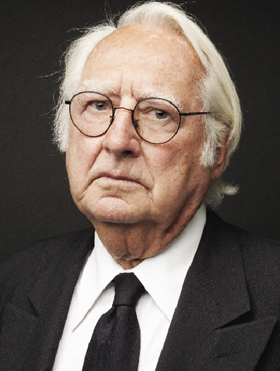Trending
The closing: Richard Meier

Richard Meier
Modernist “starchitect” Richard Meier is the managing partner of Manhattan-based Richard Meier & Partners Architects. In 1984, Meier became the youngest-ever recipient of the Pritzker Architecture Prize — the field’s highest honor. Perhaps best known for the Getty Center in Los Angeles, Meier has also designed 173 and 176 Perry Street in Manhattan and On Prospect Park in Brooklyn. His current projects include a luxury hotel in Tianjin, China, and Teachers Village in Newark, a mixed-use complex with charter schools and middle- and lower-income housing.
When were you born?
The 12th of October, 1934.
Where did you grow up?
In Maplewood, New Jersey.
Where do you live now?
Manhattan. I live in a building that was built the year I was born, 1934. It’s a conventional apartment that I made into a loft.
Do you have children?
I have two. The oldest [Joseph], lives in Washington, D.C. The youngest [furniture designer Ana Meier] got married in September, at my house in East Hampton.
What’s the status of your project in Newark?
Hopefully, in a year we’ll start construction.
Do you have a particular emotional connection to that project?
I love that you don’t have to get on an airplane to get to the site. I feel very strong ties to Newark, growing up in New Jersey. For us, it’s a very, very significant project.
I read that one of your influences was the burger chain White Castle.
I don’t know if you’d call it an influence. I remember as a young person going to White Castle, and I liked the white metal panel.
Your trademark is using white.
Well, it didn’t come from White Castle. [Laughs.]
How did it develop?
Well, I read a lot about Frank Lloyd Wright when I was young, and he always talked about organic architecture, that there was a relationship between the interior and exterior space of a building. In the first house I designed, I created walls which began on the inside of the living room and extended into the garden. When it was completed, I observed that the outside of that brick wall had moss on it, it changed colors when it rained, and the inside never changed. I said, “You know, you have to think of architecture as manmade. It doesn’t change with the weather [or] with the seasons, it’s inert.” So you may as well paint it white to reflect [back] the colors of nature.
You must get sick of explaining that.
Yes.
What is your greatest professional accomplishment?
The Getty has 5,000 visitors a day, almost the same as when it opened 10 years ago. So it’s remarkable; people keep going there and going back there.
Is there anything you regret, any mistakes you’ve made in your career?
If so, I’ve blocked it out.
What do you do in your free time?
I’ve been doing collages for 40 years. I’ve made individual collages, and I also do [them in] books with blank pages. I’ve completed 150 books.
How did you start doing that?
I was on the airplane a lot. I carried a box with glue and scraps of paper, and did them on the trips between New York and Los Angeles to pass the time away.
You carry glue with you when you travel?
Well, I used to use rubber cement. I remember I was on a trip and I had to change planes in Kansas City. And they went through my box, took out the rubber cement and they said, “This is flammable; we have to take it away.” I said, “What do you mean you’re taking my glue away?” They said, “You can have it back when you come back to Kansas City.” I said, “Don’t worry, I’m never coming back to Kansas City.” What I use now is not flammable. [Takes out a glue stick.] They can’t take this away from me.
Making collages on planes must be difficult with all the security now.
I can’t take scissors, so I cut [the paper] before I leave.
I noticed your bracelet — is that from Turkey?
Yes, it’s an evil eye [intended to ward off curses]. I’ve just worn it for years. It’s like the copper bracelets I wear — it doesn’t hurt, and maybe it helps.
What is the significance of the copper bracelets?
Well, the copper is supposed to be good for your bones. It keeps you from getting something, I don’t know — rheumatism. It’s very good for you, I recommend it.
What kind of boss are you?
Terrific. [Laughs.] You have to give people freedom to do what they do best and hope that they do it well. And if they don’t, well, then you have to make a decision.
What is something people don’t know about you?
I’m a great gardener, and a terrible cook. When I go home at night, no matter what I make, I burn it. I turn on the stove, sit down, watch television, and when the smoke starts coming, I realize that the stove was on.
What do you make of the criticism of the house you’re building for [English actor] Rowan Atkinson? Critics have said it looks like a space-age petrol station.
This is a very conservative part of England, Oxfordshire, so there are no modern houses. There are very few modern houses in England at all. So it’s a real event, and everyone has a comment.
How do you want to be remembered as an architect?
As an architect, I’d like to be remembered for the quality of the work. But ultimately, I’d like to be remembered as a good dad.




